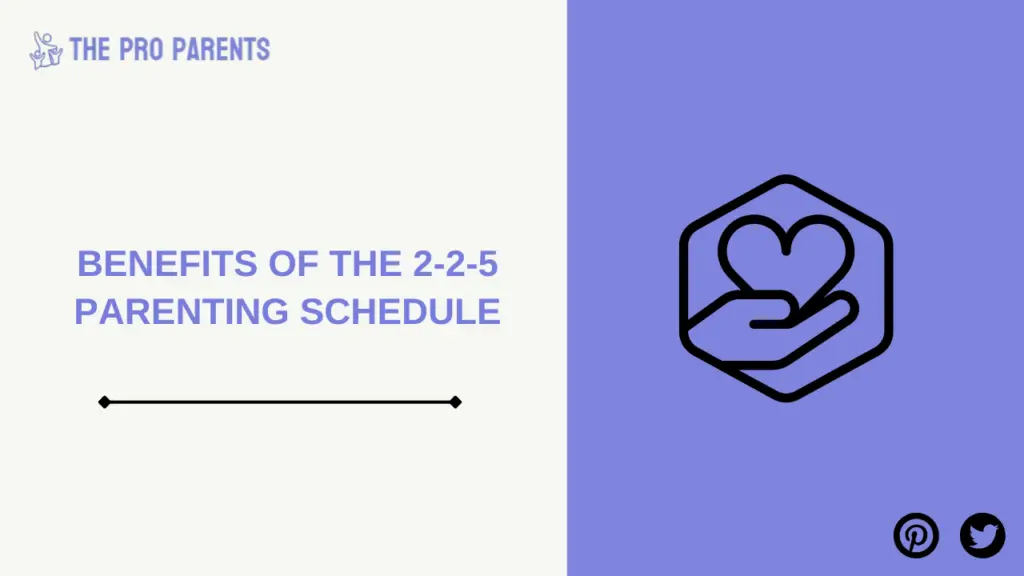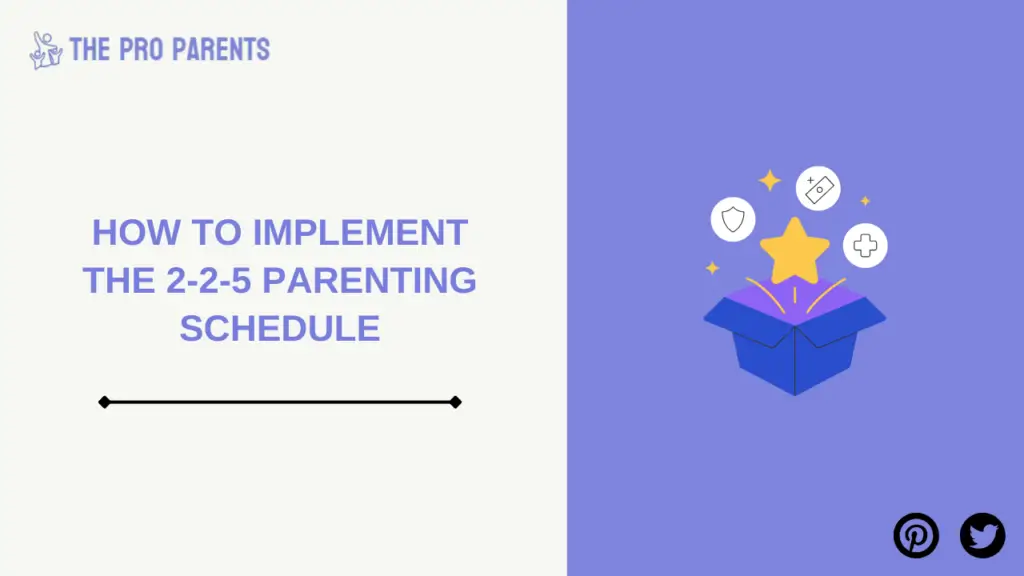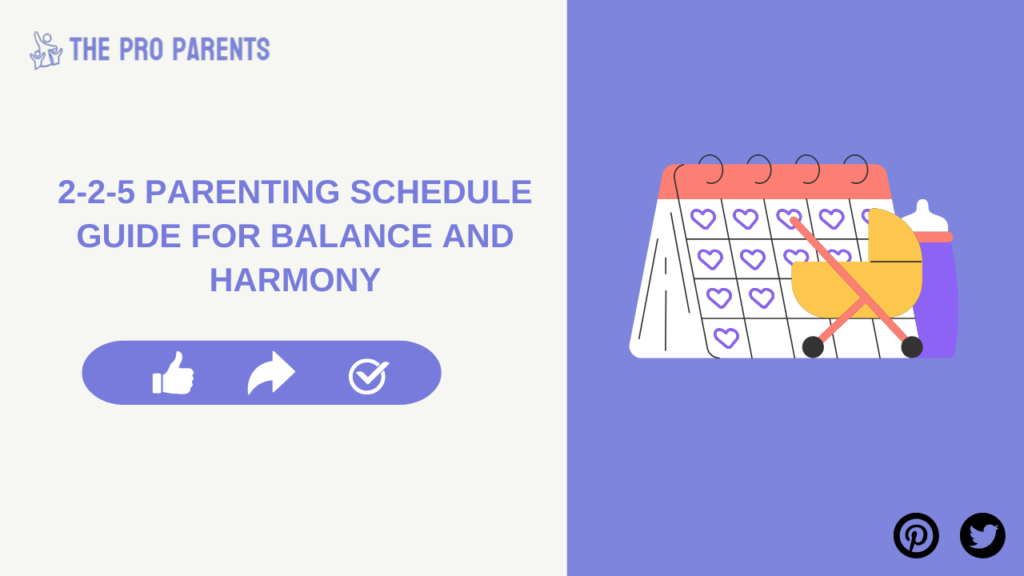Parenting can often feel like an intricate juggling act, especially when you’re co-parenting or managing life in a blended family. Spending quality time with your children is important, but so is maintaining structure and balance—for both you and your kids. Enter the 2-2-5 parenting schedule, a system designed to help families create consistency while making shared custody arrangements smoother.
This guide will break down exactly what the 2-2-5 schedule entails, explore the benefits for parents and children, and provide actionable steps to get started successfully.
Table of Contents
What is the 2-2-5 Parenting Schedule?
The 2-2-5 parenting schedule is a custody arrangement where children spend 2 days with one parent, 2 days with the other parent, and the remaining 5 days alternating each week. For example:
- Week 1 might look like this:
- Monday & Tuesday with Parent A
- Wednesday & Thursday with Parent B
- Friday through Sunday with Parent A
- Week 2 follows a similar pattern, but with Friday through Sunday spent with Parent B.
This structure ensures children regularly spend time with both parents throughout the week. By rotating the longer 5-day stretch, parents also get extended, quality time with their children to strengthen bonds.
Why is the 2-2-5 Schedule Popular Among Parents?

Many parents are gravitating toward this schedule because it provides:
- Predictability: Kids thrive on routine. The 2-2-5 structure creates a consistent schedule they can rely on.
- Balanced Time: Both parents have equal opportunities to be involved in their children’s daily lives without going long stretches apart.
- Flexibility: This arrangement can be customized based on unique family dynamics while keeping kids’ best interests at heart.
Benefits of the 2-2-5 Parenting Schedule

Adopting the 2-2-5 parenting schedule can bring a host of positive changes for children and parents alike. Here are some key advantages:
1. Consistency and Routine for Kids
Children feel more secure when they know what to expect. The structured yet predictable flow of the 2-2-5 schedule helps them stay emotionally grounded. Whether it’s school, extracurricular activities, or bedtime routines, this arrangement minimizes disruptions.
2. Work-Life Balance for Parents
For working parents, managing careers while spending quality time with your children can feel overwhelming. This schedule allows each parent a block of time to focus on their responsibilities while ensuring they’re fully present during their parenting days.
3. Improved Co-Parenting Dynamics
The equal distribution of time fosters cooperation between co-parents. Both parties have a fair share of time with their kids, minimizing potential resentment or miscommunications about spending enough time together.
4. Stronger Bonds
The alternating 5-day stretch lets parents experience longer, uninterrupted time with their kids. From family movie nights to meaningful discussions, this can deepen relationships while promoting quality over quantity.
How to Implement the 2-2-5 Parenting Schedule

Transitioning to a new parenting schedule can feel daunting at first, but with the right planning, it’s entirely manageable. Follow these steps to establish a smooth and successful 2-2-5 arrangement.
Step 1: Discuss Expectations with Your Co-Parent
Effective communication is key. Sit down with your co-parent and have an open conversation about responsibilities, logistical details, and expectations. Decide on:
- Pick-up and drop-off timings
- Responsibilities for school drop-offs, extracurriculars, etc.
- Backup plans for emergencies or when one parent is unavailable
Step 2: Create a Shared Calendar
Use a shared digital calendar (such as Google Calendar) to keep both parents informed about the agreed-upon schedule. Include important dates, such as school events and doctor appointments, to ensure seamless scheduling.
Step 3: Tailor the Schedule to Your Kids’ Needs
Every family is unique. Adjust the 2-2-5 structure to suit your children’s ages and routines:
- Toddlers may need shorter transitions, so consider an alternate 2-2-3 setup initially.
- School-aged kids can benefit from the longer consistency provided by the 5-day block.
- Teens may have specific preferences for activities or social commitments, so involve them in the decision-making process.
Step 4: Prepare Your Children
Introduce the new schedule thoughtfully:
- Explain the changes in simple, positive terms. For example, “You’ll spend 2 days with Mom, then 2 with Dad, and then 5 with each of us—fun adventures are waiting!”
- Use visual tools like printed calendars or colorful charts to make the schedule engaging for younger children.
Step 5: Stay Flexible
While consistency matters, life happens. A sick day or an unexpected work trip may require adjustments. Approach these changes with patience and prioritize your kids’ best interests.
Adjusting the Schedule During Holidays and Special Events
Holidays, birthdays, and special family gatherings can disrupt any custody schedule. The 2-2-5 framework’s flexibility makes it easier to accommodate these moments without throwing off the routine.
Tips for Holidays:
- Alternate Major Holidays:
Consider rotating major holidays (e.g., Thanksgiving with one parent, Christmas with another) or splitting the day between both parents if feasible.
- Plan in Advance:
Create a clear holiday plan at the beginning of the year to avoid last-minute stress or confusion.
Family Gatherings and Special Events:
For one-time events like family weddings or school plays, prioritize the child’s experience. Open communication will ensure both parents are aligned on how to handle these occasions.
Common Mistakes to Avoid
While the 2-2-5 schedule can be highly effective, there are a few pitfalls to avoid:
1. Overcomplicating the Schedule
Keep the schedule as simple as possible. Adding extra swaps or adjustments can confuse children and destabilize the routine.
2. Poor Communication with Your Co-Parent
Maintain ongoing communication with your co-parent to address challenges, solve misunderstandings, and keep the schedule running smoothly.
3. Neglecting Self-Care
It’s easy to focus solely on your children, but your well-being matters too. Use your “off” days to recharge, pursue hobbies, or focus on personal goals.
Case Studies of Successful 2-2-5 Parenting Schedules

Sharing real-life examples of families who have implemented the 2-2-5 schedule can provide inspiration and encouragement:
- Case Study 1:
“For our blended family, the 2-2-5 schedule has given us all breathing room. My daughter loves knowing she gets uninterrupted time with both parents.” – Maria, working mother of a 6-year-old
- Case Study 2:
“It took a little while to adjust, but now it feels second nature. The alternating 5-day stretch helps me bond with my son while still handling projects at work.” – Jason, co-parent of a 10-year-old boy
Find Balance with the 2-2-5 Parenting Schedule
The 2-2-5 parenting schedule provides a thoughtful way to balance time between co-parents while ensuring a stable, nurturing environment for children. Its structure fosters routine, equal involvement from both parents, and opportunities for relationship-building. Whether you’re in a co-parenting situation or simply exploring ways to simplify your parenting roles, this schedule offers a flexible solution.
Parenting doesn’t come with an instruction manual, but having the right tools and guidance makes a significant difference. For more advice on family dynamics, visit The Pro Parents. With the right strategies in place, you’ve got this!
FAQS
How does the 2-2-5 schedule benefit parents?
It allows both parents quality time with kids while also ensuring they get personal time for rest or activities.
Can the 2-2-5 schedule work for parents with multiple kids?
Yes, it’s flexible and can be adapted to fit the needs of multiple children, ensuring fairness and consistency.
How do I transition my child into the 2-2-5 schedule?
A: Start gradually, discuss the schedule with your child, and ensure they understand the routine to reduce anxiety.
Is the 2-2-5 schedule suitable for all types of parenting situations?
It works best in co-parenting scenarios but can be modified for different family dynamics to ensure consistency and balance.



